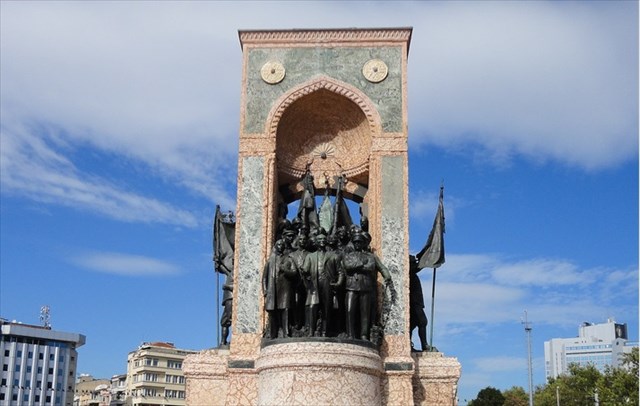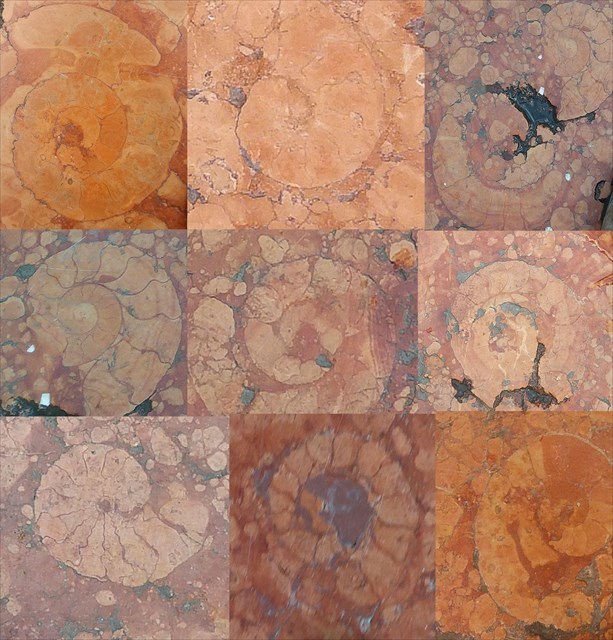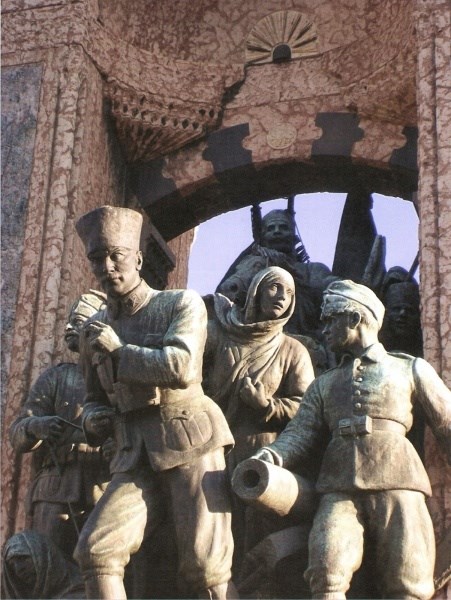Scroll down for English...
[TR]
Taksim-Cumhuriyet Anıtı
Esas adı Cumhuriyet anıtı olmasına rağmen genelde Taksim anıtı olarak bilinir. İtalyan heykeltraş Pietro Canonica'ya (Kanonika) yaptırılan ve 8 Ağustos 1928'de açılan anıtın, kaide ve çevre düzeni mimar Giulio Mongeri tarafından yapılmıştır. Anıtın bir yüzü Kurtuluş Savaşını diğer yüzü ise modern Türkiye Cumhuriyetini temsil eder. Yan yüzlerindeyse zaferi (bağımsızlığı) simgeleyen askerler ve kadın yüzleri bulunmaktadır.

İki yıldan fazla süren anıtın yapımında mermer ve bronz kullanılmış, mali kaynak için halktan bağış toplanmıştır. Ağırlığı 84 tonu bulan anıt Roma'dan İstanbul'a gemi ile getirilmiştir.
Anıtın yapım heyeti dönemin ünlü Jeologu Malik Bey’den anıtın yapılmış olduğu malzemeyi incelemesini ister. Malik Bey anıtın yapımında kullanılan ve İtalyadan gelen kayaçların İstanbul gibi biryerde açık havada uzun süre dayanamayıp deforme olacağını söyler. Her ne kadar Canonica bu sözlere karşı çıksa da yıllar Malik Beyi haklı çıkartır. Anıtın pürüzlü yüzeyinden de göreceğiniz üzere anıtın yapımında kullanılan kayaçlar zaman içerisinde deforme olmuştur.
Bu kayaçların bir kısmı Kuzey İtalya’da Verona’da çıkan Rosso Verona yani Verona Kırmızı Mermeri’dir. Rosso Verona tüm Dünya’da ve özellikle tüm İtalya’da birçok bina ve anıtta kullanılmış, sıkça görülebilir. Galleria Vittorio Emanuele (Milano) ve Neptün Çeşmesi (Bolonya) buralara örnek olarak gösterilebilir. Tıpkı buralardaki gibi Taksim Cumhuriyet Anıtı’nda da bir fosil bulunmaktadır. Fosil Rosso Verona’nın içerisinde sıkça görülen bir fosildir. Fakat heykelin neresinde bulunduğunu bulmak kolay olmayacaktır. Keskin bir göz ve araştırmacı bir ruh ile bu fosili kolayca bulacağınızı tahmin ediyorum.
Rosso Verona
Ticari dekoratif taş sektöründe, sertliği 3-5 arasında değişen ve parlak bir yüzey elde edilebilecek kayalara ‘’mermer’’ terimi kullanılır. Bunlar arasında gerçek mermerler, kalkerler, tektonik breşler ve serpantinitler gibi mermerler olmayan taşlar da bulunur. Gerçek kireçtaşları biyojenik veya kimyasal tortul kayaçlardır.
Rosso Verona Mermeri (diğer adıyla "Kırmızı Verona Mermeri"), kuzey İtalya'daki Verona eyaletinden Jura yaşlı, hematitik, nodüler bir kireç taşıdır. Bazı örneklerde ammonit fosilleri vardır (Mollusk (yumuşakça), Sephalapod (kafadan bacaklı), Ammonoidea, Ammonitida). Bu kireçtaşı, eski bir denizaltı platosu olan Trento Platosu'nda birikerek yoğunlaşan tortulların bir kısmını temsil eder.

(Milano ve Bolonya'da sokaklardaki mermerler üzerinde bulmuş olduğum ammonit fosilleri.)
Bulunduğu yerler: kuzey İtalya yakınında bir taş ocağı olan Caprino Veronese veya Cerro Veronese veya Erbezzo veya Sant'Ambrogio di Valpolicella, Verona Bölgesi, batı Veneto Bölgesi (Venetia Bölgesi), güney Alpler.
Lütfen aşağıdaki soruların cevaplarını profilime sadece mesaj ile gönderin. Log girebilmek için cevaplarınızın doğru olduğuna dair benden alacağınız cevabı beklemeniz gerekmektedir. Eğer log girdiğinizde doğru cevapları atmamış olursanız logunuz silinecektir. Her oyuncu kendi cevaplarını ayrı olarak göndermelidir. Kopyala yapıştır cevaplar kabul edilmez.
*Her ne olursa olsun fosilin fotoğrafını paylaşmayın*
Sorular:
-
Anıt üzerindeki fosilin adı nedir? (Bulmanız gereken fosil'in çapı 10 cm'den büyük (uzaktan görebileceğiniz kadar büyük) ve yerden yüksekliği 4 metreden fazla)
-
Fosili ve anıtta kullanılan Rosso Verona mermerlerinin yüzeyine dokunarak dokusunu tarif edin.
-
Fosilin anıtın neresinde bulunduğunu tarif edin. Fosilin boyutunu tahmin etmeye çalışın.
- Etrafı incelerken civarı ve sizi içine alan bir fotoğraf çekip bunu kaydınıza ekleyin. (Bunu yapmak bir zorunluluk değildir.)
Bu Earthcache'i bulurken eğleneceğinizi ümit ediyorum.
-------------------------------------------------------------------------
-------------------------------------------------------------------------
-------------------------------------------------------------------------
-------------------------------------------------------------------------
[ENG]
Do not use Google translate. Please log in English or your own language.
Taksim-The Monument of the Republic
Although its main name is the Monument of the Republic, it is generally known as the Taksim Monument. Made by the Italian sculptor Pietro Canonica (Kanonika) and opened on August 8, 1928, the monument's pedestal and the perimeter were built by architect Giulio Mongeri. One side of the monument represents the War of Independence and the other side represents the modern Republic of Turkey. On both sides, there are soldiers and women faces, representing victory (independence).
Marble and bronze were used in the construction of the monument, which was more than two years old. Donations have been collected from the people for financial resources. The monument, which weighs 84 tons, was brought from Rome to Istanbul by ship.

The monument's production committee requests the famous geologist Malik Bey to examine the material that the monument was made of. Malik Bey says that the rocks coming from Italy used in the construction of the monument can not stand for a long time in a place like Istanbul in the open air and will deform. Although Canonica opposes these words, years justify Malik Bey. As you can see from the rough surface of the monument, the marbles used in the construction of the monument have deformed over time.
Some of these rocks are Rosso Verona (the Verona Red Marble) from Northern Italy. Rosso Verona has been used in many buildings and monuments all over the world and especially in Italy. Galleria Vittorio Emanuele (Milan) and the Neptune Fountain (Bologna) are examples of these. Just like here, there is an ammonite fossil on the Taksim Monument of the Republic. This fossil is a common fossil in Rosso Verona. But it will not be easy to find where on the statue it is located.
Rosso Verona
In the commercial decorative stone trade, “marble” is used to refer to a wide variety of relatively soft rocks (H = 3 to 5) that will take a fine polish. These include true marbles and rocks that aren’t marbles, such as limestones, tectonic breccias, and serpentinites. True limestones are calcitic biogenic and chemical sedimentary rocks.
Rosso Verona Marble (a.k.a. “Red Verona Marble”) is a Jurassic-aged, hematitic, stylolitized, nodular limestone from Verona Province in northern Italy. The lighter-colored areas (nodules) have been attributed to soft-sediment deformation. Some samples have fossil ammonite shells (Mollusca, Cephalopoda, Ammonoidea, Ammonitida). This limestone represents part of a condensed succession of sediments deposited on an ancient submarine plateau, the Trento Plateau.

(Some ammonite fossils which I found in streets in Milan and Bologna on marbles.)
Locality: commercial quarry near Caprino Veronese or Cerro Veronese or Erbezzo or Sant’Ambrogio di Valpolicella, Verona Province, western Veneto Region (Venetia Region), southern Alps, northern Italy.
Please answer these questions and send them to me only via message which you can find on my profile page. If you log this cache before you send the correct answers your log will be deleted. All Geocachers should submit their own answers. Copy-paste answers will not be accepted.
* Do not share the photo of the fossil *
Questions:
-
What is the name of the fossil on the monument? (The fossil you need to find has a diameter of more than 10 cm (yes its a big one) and more than 4 meters above ground)
-
Describe the fossil and texture of the Rosso Verona marbles used in the monument by touching the surface.
-
Describe where the fossil is in the monument. Try to estimate the size of the fossil.
-
Please take a photo while you are exploring the area and attach it to your logs. (This task is not mandatory it is optional)
I hope you will enjoy this Earthcache


